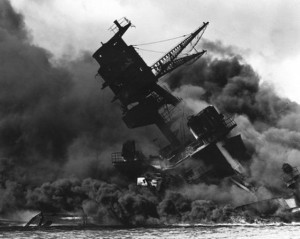Many countries have gone through traumatic episodes in their history that have changed the direction of the entire country. For the United States, that time came around 8 a.m. Sunday, December 7, 1941.
In the early morning hours, hundreds of Japanese fighter planes attacked the American naval base located at Pearl Harbor near Honolulu, Hawaii, destroying planes, cruisers, destroyers and battleships that were docked in what was known as Battleship Row. Around 2,000 men lost their lives during this attack.
The next day, President Franklin D. Roosevelt addressed Congress to get permission to declare war on Japan. The Senate unanimously approved, 82-0. The House of Representatives voted 388 -1. The one vote against was from Congressmen Jeannette Rankin from Montana, a committed pacifist who said, "As a woman I cannot go to war, and I refuse to send anyone else."
To learn more interesting facts about the attack on Pearl Harbor as well as how the whole country mobilized to defend the country, check out these titles.
Pearl Harbor, for younger readers, describes the events of the morning of the attack and the Japanese planning that went into it.
Japan 1941 considers events of the attack from the perspective of the Japanese. Why did they choose to attack, and what did they hope to gain?
Pearl Harbor: Final Judgement explores how so many clues and signals prior to the attack could have been overlooked. There is a suggestion of a high military coverup.
The DVD Tora! Tora! Tora! explores the bombing of Pearl Harbor from both the Japanese and the American perspective.
Websites
This National Geographic timeline explores what happened hour to hour that fateful day.
Check out the History Channel's extensive Pearl Harbor site, which includes the famous speech given by FDR, and other video and audio presentations.



Add a comment to: December 7, 1941: “A Date Which Will Live in Infamy”